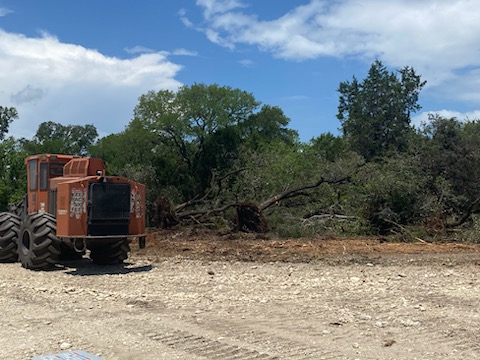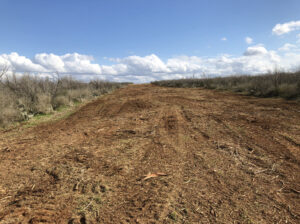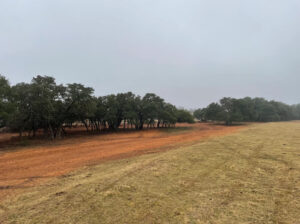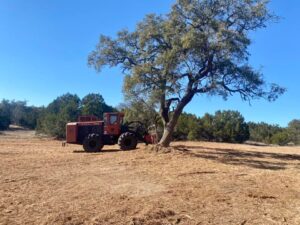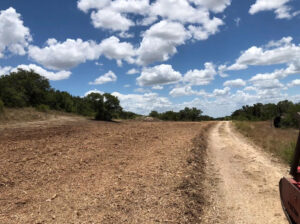If you own real estate in or around San Antonio and dream of turning dense overgrowth into usable property, you should know more about the professional land clearing process.
At Lone Star Land Services, we specialize in clearing and improving land locally and around Texas. We’d like to share the following comprehensive walk-through of land clearing, including methods, legal requirements, costs, and pro tips.
What Does Land Clearing Mean for Your Texas Property?
Land clearing isn’t just knocking down trees. In Texas, it often combines several tasks, tailored to your goals, whether you’re working on new construction, pasture, or wildlife habitat. In many of the projects we take on, the work includes:
- Brush mulching or forestry mulching: A dedicated mulcher shreds plants on the spot, leaving a layer of mulch that suppresses regrowth, limits erosion, and recycles nutrients into the soil.
- Tree removal: This includes removal of stumps and roots when you need a clean footprint for foundations, utilities, or roadbeds.
- Vegetation management: This involves selective removal to control species like Ashe juniper or mesquite, often linked to agricultural or habitat goals.
- Excavation services: Contractors use heavy equipment for grading, drainage cuts, trenches, or culverts.
- Site preparation: This includes finishing grade, soil compaction, erosion control, and preparing your land for construction or other improvements.
Of course, every property and project is unique. Experienced providers combine the needed services to deliver exactly what San Antonio landowners need.
Why Choose Mulching Over Conventional Clearing?
In appropriate settings, forestry or brush mulching tends to deliver major benefits. Because the process shreds vegetation in place, there’s no hauling, no large smoke piles, and dramatically less soil disturbance. Mulching improves moisture retention and reduces erosion, a significant advantage in San Antonio’s soils and weather conditions.
Traditional land clearing, which involves vegetation removal and hauling, provides a cleaner surface when necessary. However, it costs more in labor, trucking, tipping fees, and additional erosion controls. Your best path often mixes methods: mulch where you can, grub where needed.
What Permits, Laws, and Safety Rules Matter in San Antonio?
Clearing in local jurisdictions around Greater San Antonio involves several regulatory expectations. Here’s what you have to manage:
- If you disturb one acre or more, or as part of a larger plan, you need a stormwater permit (TXR150000) and a SWPPP (erosion plan).
- Before any excavation or trenching, always notify Texas811 (no earlier than 14 days, no later than 48 hours).
- If your clearing touches streams, wetlands, or pond edges, you may require authorization from the U.S. Army Corps of Engineers under the Clean Water Act.
- Check for burn bans or county restrictions, as outdoor burning is regulated, and local judges may impose bans.
- Watch for protected birds, nests, or endangered species.
- In city zones, tree ordinances may require permits for large or “heritage” tree removal.
- Avoid wounding oaks during February through June to mitigate oak wilt. Always paint fresh cuts to block disease vectors.
Your trusted local expert firm will bring institutional knowledge of compliance with all regulations to help your San Antonio clearing stay compliant and safe.
How To Scope a Smart Site Preparation Plan
An experienced land clearing company will help guide you with preparation for the work you need:
- Survey and flag your property lines, setbacks, and no-clear zones.
- Build temporary access with drives, culverts, and shaped ditches to control runoff.
- Install erosion and sediment controls, such as silt fences, wattles, inlet protection, and stabilized entrances.
- Mark or fence off the trees you want to save.
- Strip and stockpile topsoil carefully. After grading, stabilize exposed soil with seed, mulch, or sod.
- Where needed, add base materials to pads, driveways, or utility zones.
What Drives Cost in a San Antonio Land Clearing Job?
Several variables greatly influence how much you pay for professional land clearing services:
- Plant and tree density, size, and species
- Terrain challenges, access constraints, slope, and rock presence
- Whether brush and timber stay on site (mulched) or get hauled off
- Regulatory burdens: SWPPP, surveys, permits, environmental or habitat studies
Land Clearing and Management Can Lower Taxes, Especially in Texas
If you’re interested in lower property taxes via agricultural or wildlife valuation, vegetation management, rather than full clearing, often fits the criteria.
Texas allows an “agâ€exemption” or wildlife management valuation under certain conditions. That typically means selective removal, habitat planning, and recordkeeping. Discuss with your contractor the completion of Central Appraisal District (CAD) and Texas Parks and Wildlife Department (TPWD) forms before clearing wholesale.
Let Lone Star Land Services Be Your San Antonio Clearing Partner
There’s no need to hassle with overgrown property alone. Lone Star Land Services has deep roots in San Antonio and Bexar County, and we combine land clearing, brush mulching, site preparation, tree removal, vegetation management, forestry mulching, and excavation services under one roof.
Call (210) 473-7750 today to discuss your needs or contact us online for a free estimate.
